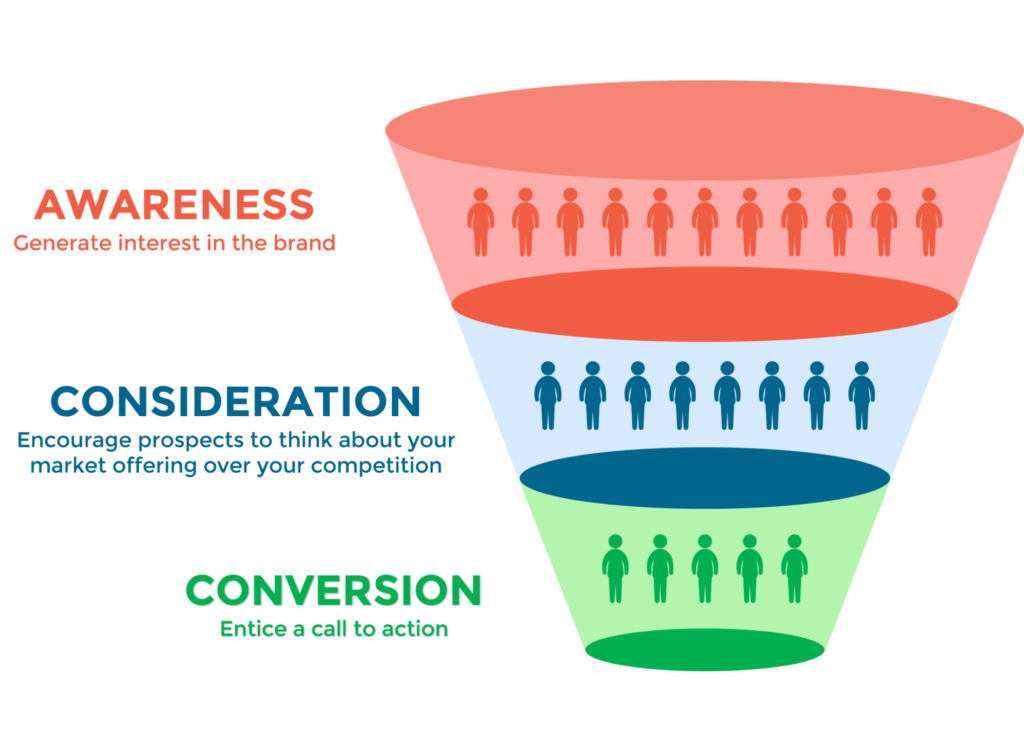Table of Contents
Let’s be honest—people don’t always buy the first time they see your brand. Sometimes, they just scroll past. Other times, they might click, have a look, and leave. And that’s okay. Buying something is a journey, not a snap decision.
So, how do you guide someone from “just looking” to “I need this”? The answer is simple: full-funnel marketing.
If that sounds complicated, don’t worry. This guide will break it down in the easiest way possible—no buzzwords, no boring lectures. Just a clear, human approach to help you connect with your audience at every step of their journey.
What Is Full-Funnel Marketing (And Why Should You Care)?
Full-funnel marketing is a way to talk to your audience based on where they are in the buying process. Instead of shouting “buy now!” You take the time to walk each person through the journey, one step at a time.
Think of it like this:
- Top of the Funnel (TOFU): People are just discovering your brand. They might not even realize what they’re looking for yet.
- Middle of the Funnel (MOFU): They’re doing research, comparing options, and looking for answers.
- Bottom of the Funnel (BOFU): They’re ready to buy—just looking for a final reason to say yes.
Full-funnel marketing helps you create the right message for each stage. It feels natural, not forced. It’s like talking to a friend, not making a sales pitch.
Why Full-Funnel Marketing Works Better
Here’s the thing—people buy from brands they trust. And trust doesn’t come from just one ad or email. It builds over time. That’s exactly what full-funnel marketing does.
Here’s why it works:
- It respects the buyer’s process. You’re not rushing them—you’re helping them decide.
- It builds trust. By giving value at every step, people start to see you as reliable.
- It increases conversions. When people feel seen and understood, they’re more likely to say yes.
- It keeps your brand top-of-mind. You’re being helpful without being pushy or over the top.
Instead of pushing people to buy, you’re inviting them into a conversation. That’s what makes this strategy powerful—and human.
Let’s Walk Through the Funnel (Stage by Stage)
Top of the Funnel (Awareness)
This is where people first hear about you. Maybe they saw a post, read a blog, or heard about you from a friend. They’re not looking to buy yet—they’re just learning.
Your goal here: Be helpful and friendly. No hard sell.
What works:
- Blog posts with tips and answers
- Social media content (reels, memes, how-tos)
- YouTube or short video explainers
- SEO-focused articles to help people find you
Example:
If you sell indoor plants, write a post like “5 Beginner Houseplants You Can’t Kill”. It’s fun, useful, and gets people interested—without trying to sell a single product (yet).
That’s the first step of full-funnel marketing: getting noticed by being helpful.
Middle of the Funnel (Consideration)
Now, your audience knows what they need. They’re comparing options and thinking, “Is this right for me?”
Your goal: Build trust and show how you solve their problem.
What works:
- Customer reviews and testimonials
- Emails that answer common questions
- Product comparisons
- Free tools, quizzes, or demos
Example:
Still selling plants? Offer a quiz: “Find the Perfect Plant for Your Space.” Or send an email: “Why Our Customers Love the Low-Maintenance Snake Plant.”
This is where full-funnel marketing becomes more personal. You’re gently guiding them forward, not pushing.
Bottom of the Funnel (Conversion)
At this stage, people are almost ready to buy. They’ve done the research, they trust you, and they just need that final reason to say yes.
Your goal: Make the decision easy.
What works:
- Special discounts or bundles
- A clear and simple checkout process
- Live chat or support
- Clear shipping and return policies
Example:
Send a friendly message like: “Still thinking it over? Here’s 10% off your first order—just in case it helps.”
At the bottom of the funnel, full-funnel marketing isn’t about closing the deal with pressure. It’s about making the decision feel safe and easy.
Don’t Stop After the Sale
Here’s something a lot of marketers forget: the journey doesn’t end when someone clicks “buy.”
You’ve earned their trust—now it’s time to keep it.
How to stay connected:
- Thank-you emails that feel personal
- How-to guides for the product they just bought
- Follow-up emails asking how things are going
- Loyalty discounts or referral rewards
This is the “after-care” stage of full-funnel marketing. It lets your customers know you’re in it for more than just the sale—you’re here to stick around.
Tools That Help You Along the Way
You don’t need fancy software to get started. But some tools can make things easier:
- Email tools: Mailchimp, ConvertKit
- Social media: Instagram, TikTok, Facebook
- CRM tools: HubSpot, Zoho (for lead tracking)
- Ad tools: Google Ads, Meta Ads (for retargeting)
- Analytics: Google Analytics, Hotjar (to see what’s working)
The key is to use what fits your business—and focus more on what you say, not just where you say it.
Simple Tips to Get Started
If this all feels like a lot, don’t worry. You don’t need to tackle it all in one go.
Start small with these steps:
- Think like your customer. What do they need at each step?
- Create one piece of content per funnel stage. That’s it. One blog, one email, one offer.
- Be real in your tone. Talk like a human, not a marketer.
- Track your results. What’s getting clicks? What’s not? Learn and improve.
- Keep showing up. Consistency beats perfection every time.
Final Thoughts: Be Helpful, Not Salesy
Full-funnel marketing isn’t a secret formula. It’s just a better way to talk to your audience. It’s all about growing a connection, slowly and genuinely.
You don’t have to be loud or clever. You just have to be real.
So when you’re mapping out your next campaign, pause and ask yourself:
“Where is my customer in their journey—and how can I help them right now?”
That question alone can guide your entire marketing strategy.

